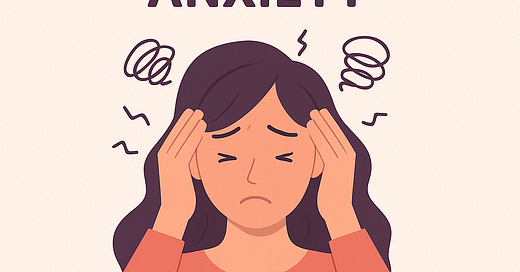You’ve probably seen it in session: a client says, “I’m terrified—and I’m doing it anyway.” And in that moment, something shifts. The fear doesn’t disappear, but it stops running the show. They move toward what matters, even if they have anxiety.
That’s emotional interference—when two strong, opposing emotional signals try to occupy the same space.
And the brain has to choose.
When a client taps into a different emotional channel—even briefly—it can interrupt anxiety’s monopoly and create space for a new response.
I would use this strategy when an anxiety or phobic response was getting in the way of living a life consistent with a client’s values. For example, being able to attend a child's school performance, filling out a job application, or to aid in doing exposure therapy with something like agoraphobia
The Science Behind Emotional Interference
Here’s why this could work:
🧠 1. The Inhibitory Learning Model
According to Craske and colleagues, exposure therapy isn’t about unlearning fear—it’s about creating new learning that competes with the old. Fear doesn’t get erased; it gets overridden by safety. This is most effective when the client experiences something unexpected. We can also try to do this with courage, playfulness, or curiosity—in the face of a feared situation.
This emotional mismatch tells the brain: “Wait—this might not be danger after all.”
📖 Source: Craske et al. (2014). Maximizing exposure therapy: An inhibitory learning approach.
🎭 2. Emotion-Focused Therapy (EFT)
Leslie Greenberg’s work also shows that one emotion can transform another. For example, clients may need to access empowered anger or compassion to interrupt helpless anxiety. This process—“emotion regulation through emotion activation”—relies on the idea that emotions are not just symptoms, but pathways to change.
😅 3. Affective Neuroscience
According to Jaak Panksepp’s research, emotional states compete for dominance in the brain. The fear system and play system, for example, run on different circuits. Engaging joy, humor, or curiosity can actually modulate amygdala activity, reducing the intensity of fear responses.
💥 4. DBT: Opposite Action (Linehan)
In Dialectical Behavior Therapy, Marsha Linehan teaches opposite action: when an emotion urges avoidance, you do the opposite—approach, engage, soften.
This is about sending the body a different message. Acting calm or connected can shift the emotional state itself.
This lines up with emotional interference: behavior can disrupt fear’s hold and open the door to a new experience.
📖 Source: Linehan, M.M. (2015). DBT® Skills Training Manual, 2nd ed.
4. Clinical Wisdom and Therapist Practices
You’ve probably said it in session: “Try saying that anxious thought in a silly voice.” “Call up your inner protector.” These ideas are grounded in what the nervous system actually needs: a different emotional signal.
And they’re supported by evidence-based models:
In Acceptance and Commitment Therapy (ACT), these techniques align with creative defusion and committed action—ways to unhook from the literal content of anxious thoughts and shift toward more flexible, values-based behavior.
In Internal Family Systems (IFS), calling up an “inner protector” engages parts work, allowing clients to relate to their anxiety with curiosity and self-leadership, rather than fusion or fear.
What might look playful on the surface is actually deep nervous system work. These strategies make space for agency, choice, and even self-trust—often right in the heart of a fear response.
The Competing Emotion Switch in Practice
So, how do you help clients activate this switch in the room?
Try these:
Ask: “If you could invite one emotion alongside the fear, not to erase it, but to challenge it, what would it be?”
Let them exaggerate the fear until it turns absurd.
Get curious: “What’s one weird or interesting thing happening in your body right now?”
Use humor or awe as intentional counterweights.
Of course, this doesn’t mean bypassing or pushing past fear.
Clients still need titration, safety, and co-regulation. But emotional interference can unlock deeper work once their nervous system has some capacity.
Not to suppress fear but to interrupt its dominance.
I don’t specialize in anxiety anymore, but I have tons of recordings and notes that I love to sort through, organize, and ponder. This is what I’m thinking about today.
Want to Try This with Clients?
I've compiled a simple worksheet to guide clients through the Competing Emotion Switch. It’s worksheet 4 in the series, and it's free along with the others.
If you like this post please share it or comment!
Warmly,
Kristen McClure
The Curious Therapist





